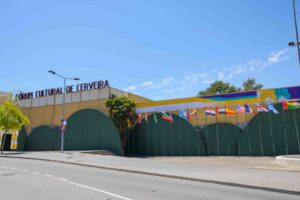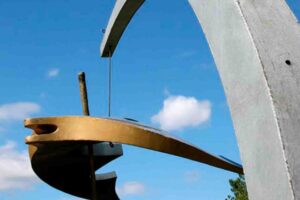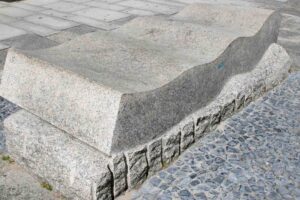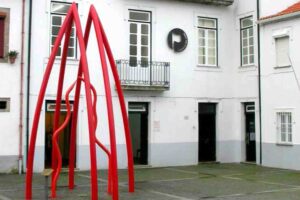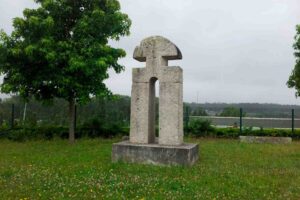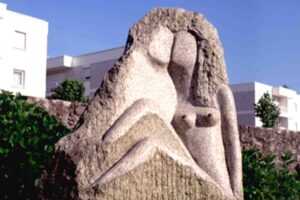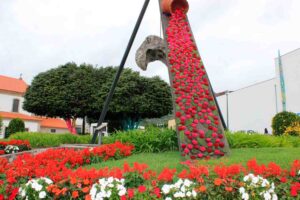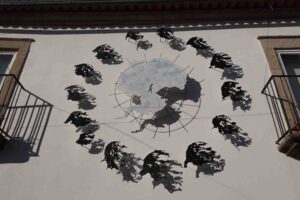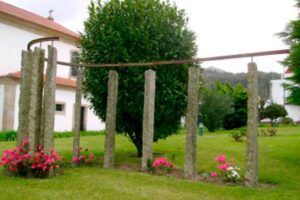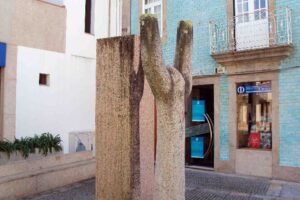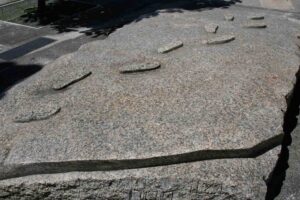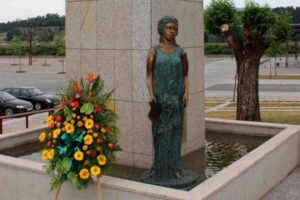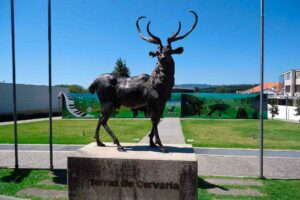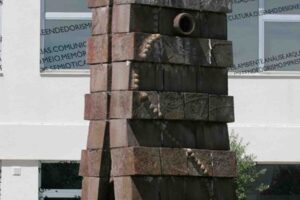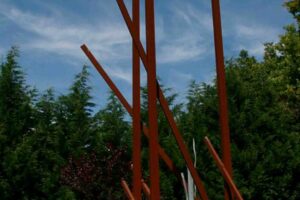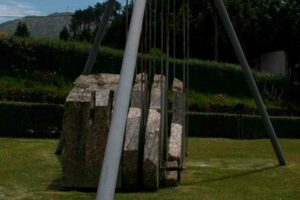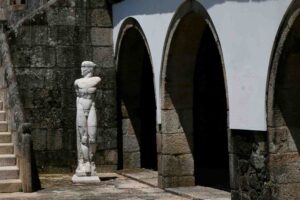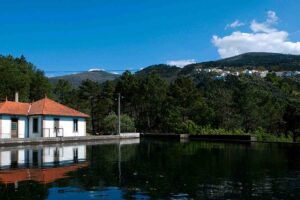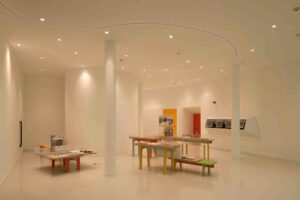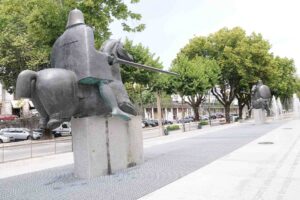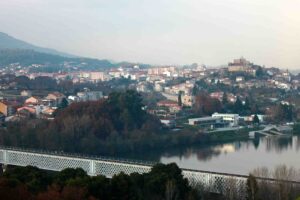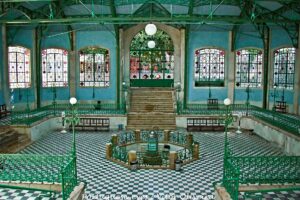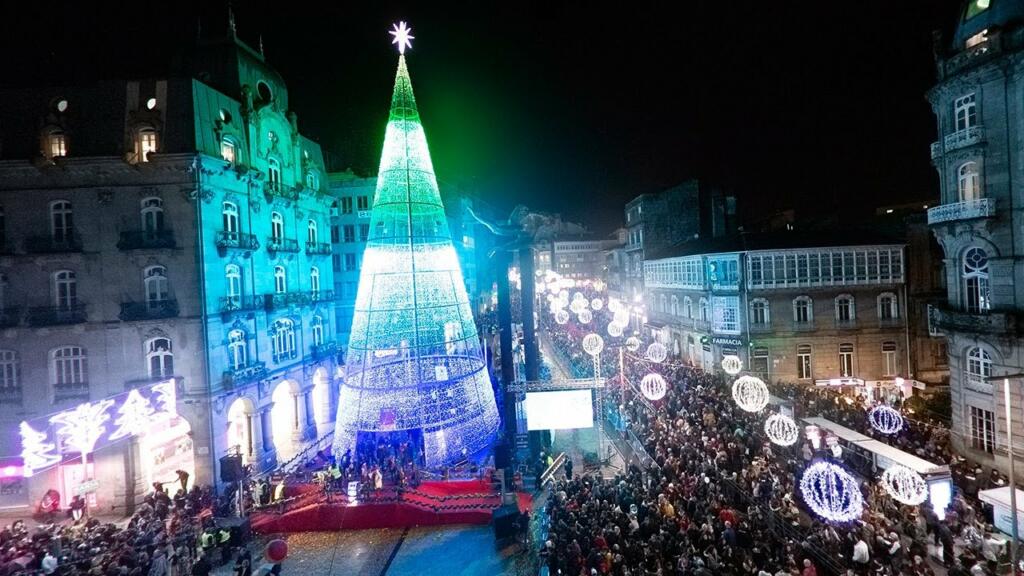
Contemporary and Modern Art Itinerary in Alto Minho
Alto Minho is one of the greatest showcases of contemporary and modern art in Portugal.
The northern region of Portugal is highly visited by enthusiasts and artists seeking inspiration and the opportunity to see the work of renowned artists.
One of the most visited cities in Minho region, which showcases a significant number of contemporary and modern artworks, is Viana do Castelo.
The city of Viana do Castelo boasts several notable attractions in its portfolio, including the Praça da Liberdade (Freedom Square), the Municipal Library, the Cultural Center, the Eiffel Bridge, and the Sanctuary of Monte de Santa Luzia.
All of them are significant landmarks in the history of Portuguese architecture.
If you want to know more details about each of these spaces before visiting them, check out our architecture itinerary for Viana do Castelo.
Indeed, besides Viana do Castelo, there are other places in Alto Minho with a strong offering of contemporary and modern art to visit.
Vila Nova de Cerveira is indeed the second city in Minho with a significant presence of modern and contemporary art, right after Viana do Castelo.
In Vila Nova de Cerveira, for example, you can visit:
In the other cities of Alto Minho, there are these places:
- Municipal Earth Office Building in Ponte de Lima
- Paradamonte Hydroelectric Power Station in Ponte da Barca
- PPCB Environmental Studies and Interpretation Center in Paredes de Coura
- Sculpture of the Battle of Valdevez, in Arcos de Valdevez
- Municipal Library of Caminha
- Metal Bridge over the Minho River, in Valença
- Peso Thermal Park, in Melgaço
If you want to learn more details about each one, then keep reading our article and stay informed about all the modern and contemporary aspects encompassed in these spaces.
Cervo by José Rodrigues, in Vila Nova de Cerveira
The “Cervo” (Deer) in Vila Nova de Cerveira is a sculpture created by the renowned artist José Rodrigues.
It is located at the top of Monte da Encarnação and was inaugurated in 1985.
At the time, José Rodrigues was one of the most prestigious artists in Portuguese sculpture.
In Portugal, he created several sculptures in bronze, metals, and stones.
According to historical accounts, the sculptor had great appreciation for materials and believed that art was a way to connect urban contexts with landscapes.
The Cervo sculpture in Vila Nova de Cerveira is an example of how José Rodrigues combined sculpture with the historical contexts of each location.
This is because the deer, or “cervo” in Portuguese, is the main symbol of the town and is even associated with the origin of the name Vila Nova de Cerveira.
And why is the deer the main symbol of this town?
All because of the legend of the “Cervo Rei” (King Stag).
The legend of the “Cervo Rei” tells that it defeated, along with its herd, all human invaders who sought to take over the village.
The goal was to keep that place exclusively reserved for animals forever.
Later, in a second encounter, the legend says that the “Cervo Rei” single-handedly defeated a Portuguese knight, and that’s how Vila Nova de Cerveira originated.
Whether true or not, the fact is that due to this legend, the deer became the main symbol of Vila Nova de Cerveira.
And in this sculpture, artist José Rodrigues wanted to pay homage to it, connecting the town to its own urban legend.
The sculpture was made of iron and is established on four concrete pillars to ensure its stability and stand out amidst the surroundings of the village.
The way it was developed allows it to be seen from a distance of approximately 10 km.
However, it is worth visiting and seeing the Cervo up close, also due to its location.
In addition to the magnificent artwork, visitors can also enjoy a fantastic view of the Minho Valley and Galicia.
José Rodrigues’ Cervo is, therefore, a must-visit for all enthusiasts of contemporary and modern art who are exploring the Alto Minho region.
Cerveira Cultural Forum in Vila Nova de Cerveira
The Cultural Forum of Cerveira is the venue for one of Portugal’s main exhibitions of contemporary and modern art: the International Biennial of Art of Vila Nova de Cerveira.
The event takes place every two years and is responsible for bringing contemporary art to the village.
However, exhibitions of contemporary and modern art in this space are not limited to the Cerveira Biennial.
The Cerveira Cultural Forum also houses a museum that hosts various temporary exhibitions throughout the year and brings together works from the various editions of the Biennial, from 1978 to the present day.
In total, the Museum of the Cerveira Cultural Forum gathers around 700 artworks, featuring both national and international artists.
In 2019, the museum was indeed recognized as the “Best Portuguese Museum of the Year” by the Portuguese Association of Museology (APOM).
Therefore, if you are a fan of contemporary and modern art and are on vacation in Alto Minho, be sure to visit the Cultural Forum of Cerveira, especially during the International Biennial of Art of Vila Nova de Cerveira.
And if you want to learn more about the exhibited artworks in the museum, audio guides or guided tours by specialized technicians in contemporary and modern art are available to provide you with a deeper understanding of the pieces.
Artistic Itinerary in Vila Nova de Cerveira
Vila Nova de Cerveira is known as the village of arts.
This is because it is possible to glimpse several works of art scattered throughout the village.
Despite José Rodrigues’ Cervo being the most well-known, there are many other artworks in Vila Nova de Cerveira that deserve to be highlighted and mentioned in this article.
And not only mentioned but also worth a visit.
The City Council of the village itself has developed an Arts Itinerary that indicates which artworks contemporary and modern art lovers must visit.
They are as follows:
Abel and Cain – Sculpture by Alberto Vieira representing the sons of Adam and Eve.
Alto Relevo – by Artur Moreira.
Avecristo – Sculpture by Manuel Patinha developed with steel, bronze, and granite..
Banco Ondulado – Granite structure by Silvério Ribas with a wavy shape. It is located in front of Solar dos Castros.
Catedral – Wood and resin sculpture by Isabel Cabral and Rodrigo Cabral, which exemplifies a para-surrealist and experimental language. It combines the malleability of exposed corten steel with polychromatic material.
Dólmen Galaico Duriense – Sculpture by Manuel Patinha, created with steel, bronze, and granite.
Enamorados – Sculpture by Maria José Caramez.
Esforço –Sculpture by the same author as the Cervo, José Rodrigues, composed of iron elements, a suspended stone, and a water fountain. It is located next to the garden and the main church of Vila Nova de Cerveira.
Evolution and Theory – Artwork by contemporary Israeli sculptor and painter Zadok Ben-David, resulting from his exhibition held in Vila Nova de Cerveira in the year 2003.
Granito-Ritmo – Sculpture by Clara Meneres, created using iron and granite.
Homenagem Orgânica – Sculpture by João Antero, located in Largo do Terreiro.
Lembranças de uma noite de Verão – Artwork by Xuxo Ora Claro, representing footprints and located in front of the Tourism Office of Vila Nova de Cerveira.
Memorial to the Cerveirenses Fallen in the Colonial War – a sculpture by Sousa Pereira depicting a woman with a distant gaze and a letter in her hand. In this sculpture, the author chose not to emphasize the figure of the combatant but to pay tribute to the courage of the women who awaited the return of their husbands.
Commemorative Mural of the 25 years of the Cerveira Biennial – a hand-painted panel created by Acácio de Carvalho and located on the gable of the building adjacent to the Millennium BCP branch in Praça do Alto Minho, in the center of the Village of the Arts.
Navegações – Another work by sculptor José Rodrigues. Its structure is made of metal, and the artwork was created to pay homage to fishermen and sailors. It is located in Parque do Castelinho, by the Minho River.
O Rei Veado – Another artistic contribution by Zadok Ben-David to Vila Nova de Cerveira. It is a bronze sculpture located at the southern roundabout of the town, on the EN13 road. Its form depicts the figure of a deer.
Ponte da Cultura – Work by the artist Arcádio Blascos.
Por cada árvore interrompida o crescimento de uma floresta – Artwork by Carlos Marques that combines iron, bronze, stone, and natural elements.
Rio, Água e Sangue – Artwork by Silvestre Pestana featuring neon lights. It stands six meters tall and takes the form of a needle of light. It is composed of twelve linear neon bars in white, blue, and red colors.
Seara Mecânica – Artwork by Carlos Barreira that combines iron and stone.
S. Sebastião – Stone sculpture by Manuel Rosa.
Explore this itinerary and be amazed by the art spread throughout the streets of Vila Nova de Cerveira.
A luxurious journey that all art enthusiasts should embark on.
Covas Hydroelectric Power Plant in Vila Nova de Cerveira
Indeed, you may be wondering, “Why is a hydroelectric power plant included in an art itinerary?”
However, the truth is that the Covas Hydroelectric Power Plant features fascinating artistic details in its architecture.
The building was constructed using granite masonry and features wooden structures and ceramic roof tiles.
Its floor plan is rectangular, and on the south-facing facade, the fenestration consists of rectangular openings, with a door topped by a window on the left side and a window/door framed by two windows on the right side.
It is indeed a landmark of contemporary and modern Portuguese architecture in the Alto Minho region, deserving to be regarded as a true artistic work and worth visiting.
Municipal Earth Office Building in Ponte de Lima
The Gabinete Terra building in Ponte de Lima is a tourist attraction in the Alto Minho region.
It serves as a hub for promoting the municipality and its events, but it is also an emblematic work of modern architecture designed by the architect João Álvaro Rocha.
His work aims to symbolize, through architectural features, the socio-cultural and economic dynamism of the municipality.
Paradamonte Hydroelectric Power Station in Ponte da Barca
The Paradamonte Hydroelectric Power Station, in Ponte da Barca, is another artistic work of modern and contemporary Portuguese architecture.
It is a long and very elegant ochre building, with large vertical windows.
It was the first major hydroelectric power station in Portugal and started operating in 1922.
PPCB Environmental Studies and Interpretation Center in Paredes de Coura
The Center for Environmental Studies and Interpretation of PPCB in Paredes de Coura was originally built by the Internal Colonization Board in the 20th century.
Later, it was restored and renovated with a modern and contemporary architectural style.
New volumes were added that relate to the existing ones and maintain sufficient distances to allow for individual observation of each one.
The new volumes are materialized with an exterior wooden cladding, standing out from the pre-existing buildings.
In this way, visitors to the Center for Environmental Studies and Interpretation of PPCB in Paredes de Coura can perceive the differences between the volumes created before the renovation and those built afterward.
As part of the space recovery, a large tree mass was also added, giving the main building the appearance of a negative space within a large constructed mass.
The covered square located beneath the building was designed as an artificial island to stand out from the surrounding natural pavement.
With all these renovations, the Center for Environmental Studies and Interpretation of PPCB in Paredes de Coura has become one of the major landmarks of contemporary and modern architecture in Alto Minho, making it a must-visit location for those following this art itinerary in the region.
Sculpture of the Battle of Valdevez, in Arcos de Valdevez
A sculpture with a story behind it.
That is the case of the Sculpture of the Battle of Valdevez, in Arcos de Valdevez, another work by José Rodrigues.
This sculpture, made of bronze and stone, represents one of the most significant moments in the history of Portugal.
That moment is when the armies of D. Afonso Henriques and Afonso VII of Castile and León meet by the riverbank in Arcos de Valdevez and engage in a medieval tournament.
This tournament was named “Recontro de Valdevez” and it prevented a large-scale battle from taking place.
Instead of engaging in a full-fledged battle, they selected the best knights from both sides and fought in a tournament. This way, they avoided shedding blood in the confrontation.
The men of D. Afonso Henriques emerged victorious in the tournament, which enabled them to advance the independence of the County of Portucale.
This moment is one of the most important in the foundation of Portugal and, for that reason, it deserved to be commemorated.
The tribute came in the form of the sculpture conceived by José Rodrigues, which can be observed up close at Campo do Trasladário in Arcos de Valdevez.
Municipal Library of Caminha
Indeed, the Municipal Library of Caminha is not just another library.
it is also a work of art in modern and contemporary architecture.
Whether it is because of the fact that it has parts of the upper floor suspended over the street or its large glazed surfaces that make use of natural light, several modernist lines are evident in this building.
Also, as it does not have partitions between different spaces in the library, the interior conveys a fantastic sense of space and openness to those who visit it.
The project was developed by architect Nuno Brandão Costa, who chose granite as the main material for this work.
Whether you are a fan of reading or not, visit the Caminha Municipal Library to appreciate up close its beautiful architecture.
Metal Bridge over the Minho River, in Valença
The Metal Bridge over the River Minho in Valença is an architectural work that dates back to 1886.
It originated from an agreement between the governments of Portugal and Spain in 1879 and was designed by the Spanish engineer Pelaio Mancebo.
The project was developed to facilitate the exchange of goods between the two countries, as prior to the construction of the bridge, the only option was through river transportation.
From the need to facilitate trade between Spain and Portugal, emerged an iconic modern and contemporary architectural masterpiece in Alto Minho.
Among the main architectural features that deserve attention, one notable aspect is that the bridge is entirely built in iron and is the only bridge with dual roadway and railway decks, with the two decks connected by crossed oblique beams.
Architecturally, other notable features include the side footpaths, the masonry and ashlar pillars with a subcircular plan, and two meeting piers, quadrangular in shape, with two levels. The lower level features a perfectly arched opening and the upper level has two arches of the same profile providing access to the footpaths.
If you’re vacationing in Alto Minho, take the opportunity to take a walk across the bridge and admire these excellent details of modern and contemporary Portuguese architecture up close.
Peso Thermal Park, in Melgaço
For those who want to combine relaxing moments with visits to modern and contemporary architectural works during their vacation in Alto Minho, the Peso Thermal Park, in Melgaço is the ideal place to visit.
In addition to the spa services and thermal treatments it offers, the park is one of the most famous modern and contemporary architectural works in Alto Minho.
The building of the main fountain is quite eclectic, combining elements of iron with decorative elements of Art Nouveau and Art Deco.
The bathhouse, on the other hand, features a contemporary construction combined with neoclassical elements and the romantic language often found in 20th-century thermal architecture.
The entire architecture of the park was designed to harmonize with the surrounding landscape and create a relaxing atmosphere for visitors.
Visiting the Thermal Park of Peso in Melgaço is, therefore, a great way to spend one of your days during your vacation in Alto Minho.
If you’re planning to visit the Minho region but haven’t decided where to stay yet, consider making a reservation at AP Dona Aninhas, the hotel belonging to the AP Hotels & Resorts group located in Viana do Castelo.
The hotel is situated in the center of Viana do Castelo and offers various amenities such as a spa, bar, and restaurant. Combined with the comfort of our rooms, your stay will be unforgettable.
Visit this wonderful region, full of activities and history, and ensure unique conditions for your stay at the AP Dona Aninhas hotel.


